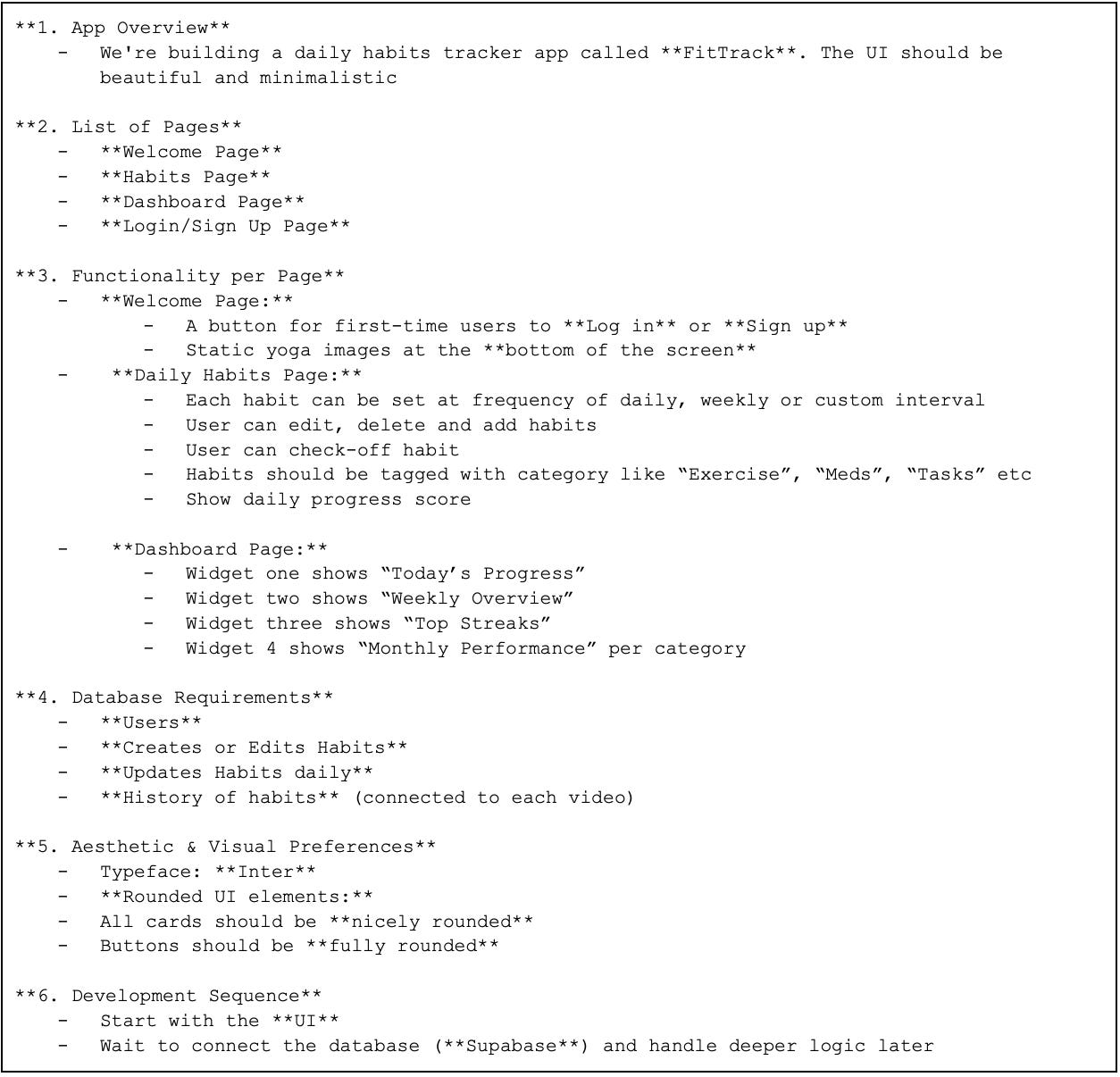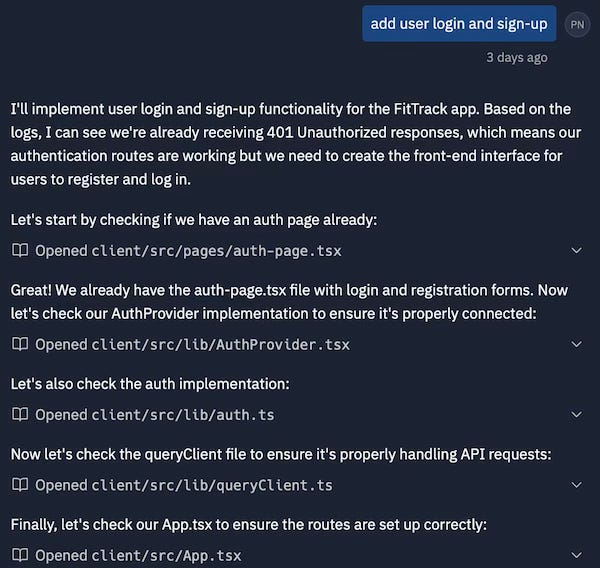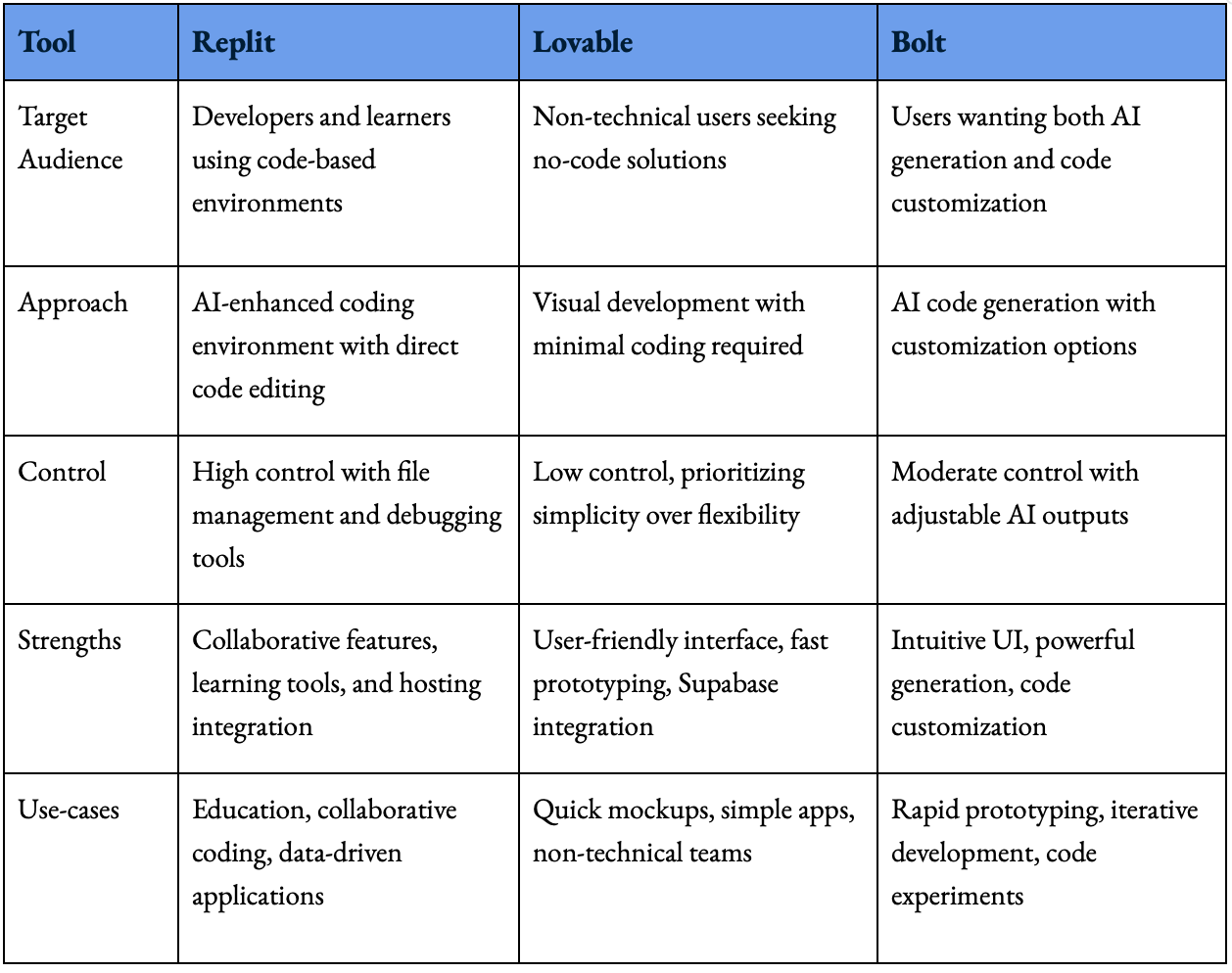Comparing AI Code-Gen Tools: A Personal Journey
In this blog, I dive deep into three leading AI code-generation tools—Replit, Lovable, and Bolt—by challenging each platform with identical prompts to build the same prototype. My hands-on comparison reveals striking differences in their approaches, capabilities, and ideal use cases. Stay tuned for a follow-up piece where I'll document the journey from prototype to deployment using these revolutionary tools.
My Unexpected Dive into the World of AI Coding
My journey with AI coding tools began quite unexpectedly. What started as a chance encounter with Bolt quickly evolved into a exploration of how these tools could transform software development for someone like me - a technically strong product manager with systems knowledge but limited coding skills. I had no intention of learning to code traditionally, but I was curious about what these AI-powered platforms could do.
After initial research, I narrowed my focus, skipping tools like Cursor and Windsurf which are better suited for professional developers, skipping V0 due to timing constraints, and newcomers like Firebase. Instead, I concentrated on usage of three promising platforms: Replit, Lovable AI, and Bolt.
Learning the Ropes
I leveraged YouTube tutorials ( link1 and link2) to help me understand how expert builders leverage these tools. These tutorials have helped a lot in converting me from a curious beginner to someone who could effectively utilize these powerful tools.
To evaluate them fairly, I built the same prototype across all three platforms using identical initial prompts and went through debugging and iterative updates based on the response to the initial prompt. While I did not deploy the final app, this approach provided valuable insights into each platform's capabilities and limitations
The Prompt
Three Contenders: A Closer Look
Replit: The Developer's Companion
Replit provides a familiar code-based environment enhanced with AI assistance. It feels like working with a brilliant colleague who completes your thoughts and suggests better solutions. The browser-based IDE and multiplayer features make it ideal for collaborative projects and learning scenarios. Replit shines when you want to experiment quickly while still maintaining control over your code.
In this example for adding user authentication, the tool provides a detailed outline of the changes. The dropdown button on the right hand side allows you to access the code
Lovable: The No-Code Expert
Lovable takes a radically different approach, focusing on simplicity and accessibility for non-technical users. Its prompt-to-code capabilities and clean GitHub exports make it perfect for founders and product managers who need to quickly transform ideas into functional prototypes. With Lovable, I could focus entirely on design and functionality without worrying about syntax or complex debugging.
In the similar example of adding user authentication, Lovable emits a bunch of SQL code and prompts the user if it should move forward with implementation. When the user accepts the changes, it moves forward with creation of the code and gives a summary of the implemented modules
Bolt: The Future of Development
Bolt strikes an impressive balance between AI-powered generation and manual control. Its real-time preview and full-stack app generation capabilities make it stand out for developers embracing an AI-first stack. With Bolt, I felt like I was experiencing the future of software development—powerful AI assistance without sacrificing the ability to customize and control the output.
Side-by-Side Comparison
Verdict: Which Tool Is Right for You?
After elaborate testing, here's my assessment
Choose Replit if you want to learn while building, enjoy collaborative coding, or need integrated hosting and deployment tools. It's perfect for those who want to dip their toes into actual coding without being overwhelmed.
Choose Lovable if you're a founder or product manager who needs to quickly transform ideas into functional prototypes without dealing with code. Its clean exports to GitHub make it ideal for creating projects you'll eventually hand off to developers.
Choose Bolt if you're looking for that perfect balance between AI-powered generation and manual control. It looks like the most future-forward of the three and feels like a glimpse of where all development environments are heading.
Game-Changing Implications for Product Managers
These AI coding tools aren't just nice-to-have additions, they are revolutionary game-changers for product managers
Complex prototypes that required developer bandwidth? Build them yourself today. Product roadmaps that seemed impossible with your timeline and resources? Product teams can reach alignment faster as prototyping is reduced to hours. PM can share prototype and PRD to the product teams and drive alignment faster
This paradigm shift demands more from PMs, not less. As technical barriers fall, your core skills become even more crucial. Anyone can build an app, but understanding which app solves the right problem still requires your expertise.
The democratization of development doesn't eliminate the need for systems knowledge, security awareness, and architectural thinking—it simply allows more people to participate in the creation process.
The competitive advantage now lies in how quickly you can iterate on user feedback, test hypotheses, and pivot when necessary. Tomorrow's star PMs will be those who leverage these AI partners not to replace development teams but to accelerate the journey from idea to validated solution.
The future belongs to product managers who embrace these tools without losing sight of what truly matters: solving real user problems in meaningful ways. The code is now the easy part—the vision is where you add irreplaceable value.








